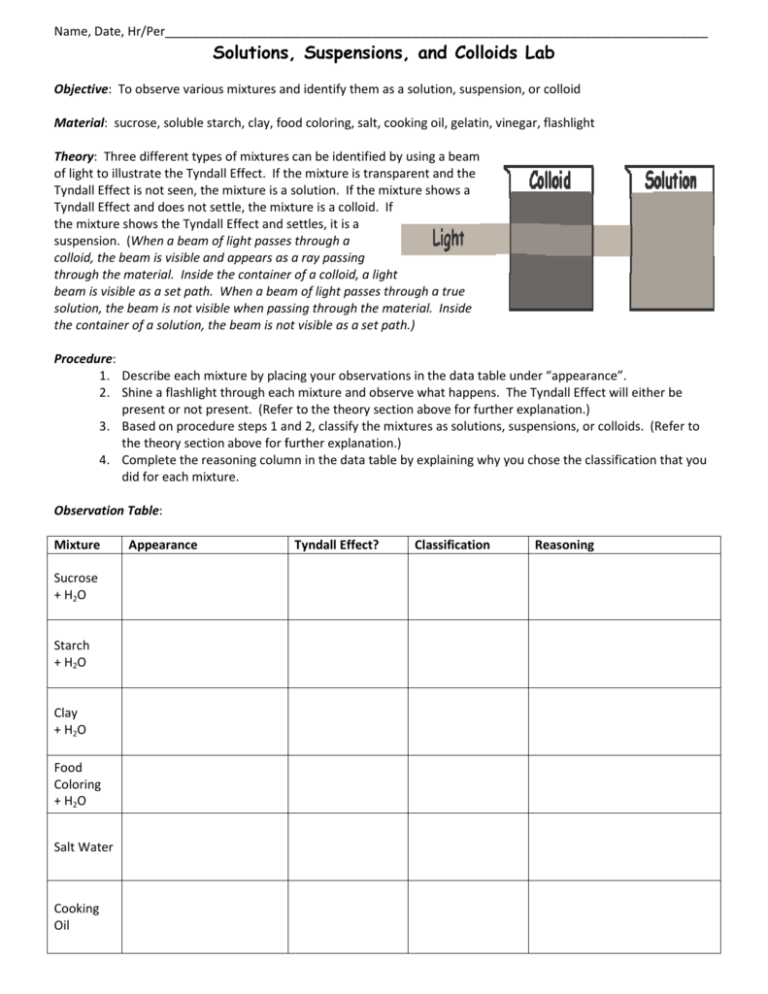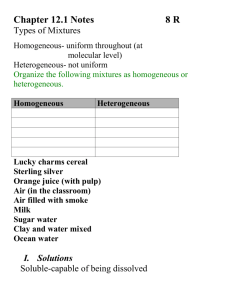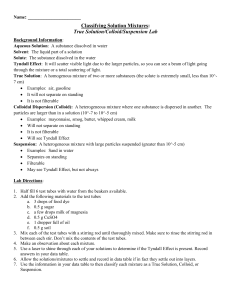Solutions, Suspensions, and Colloids Lab
advertisement

Name, Date, Hr/Per_______________________________________________________________________________ Solutions, Suspensions, and Colloids Lab Objective:: To observe various mixtures and identify them as a solution, suspension, or colloid Material:: sucrose, soluble starch, clay, food coloring, salt, cooking oil, gelatin, vinegar, flashlight Theory:: Three different types of mixtures can be identified by using a beam of light to illustrate the Tyndall Effect. If the mixture is transparent and th the Tyndall Effect is not seen, the mixture is a solution. If the mixture shows a Tyndall Effect and does not settle, the mixture is a colloid. If the mixture shows the Tyndall Effect and settles, it is a suspension. (When When a beam of light passes through a colloid, the beam is visible and appears as a ray passing through the material. Inside the container of a colloid, a light beam is visible as a set path. When a beam of light passes through a true solution, the beam is not visible when passing through tthe material. Inside the container of a solution, the beam is not visible as a set path.) Procedure: 1. Describe each mixture by placing your observations in the data table under “appearance”. “appearance” 2. Shine a flashlight through each mixture and observe what happens. The Tyndall Effect will either be present or not present. (Refer to the theory section above for further explanation.) 3. Based on procedure steps 1 and 2, classify the mixtures as solutions, suspensions, or colloids. (Refer to the theory section above for or further explanation.) 4. Complete the reasoning column in the data table by explaining why you chose the classification that you did for each mixture. Observation Table: Mixture Sucrose + H2O Starch + H2O Clay + H2O Food Coloring + H2O Salt Water Cooking Oil Appearance Tyndall Effect? Classification Reasoning Mixture Appearance Tyndall Effect? Classification Reasoning Gelatin Vinegar Questions/Analysis: 1. What is a mixture? 2. Contrast homogeneous and heterogeneous mixtures. [Contrast = How are they DIFFERENT?] 3. Define solution, suspension, and colloid. a. Solution- b. Suspension- c. Colloid- 4. Identify each type of mixture as homogeneous or heterogeneous. Explain why you chose each type of classification. a. Solution- b. Suspension- c. Colloid- 5. How do the particle sizes compare in solutions, suspensions, and colloids? 6. For each solution, identify the solute and solvent.






